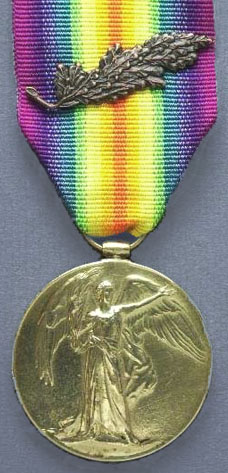Mentioned in Despatches (MiD)

British commanders-in-chief of a theatre of war or campaign were obliged to report their activities and achievements to the War Office in the form of despatches, which were published in The Gazette.
Many attached lists of men deemed worthy of a mention, though text explaining the precise reason why a particular individual was chosen is uncommon. Some were mentioned on multiple occasions.
- To be mentioned in despatches can be a condition of receiving certain decorations. Though not a medal, for actions during WW1, soldiers were entitled to receive a certificate and wear a decoration of a spray of oak leaves in bronze (instigated in an Army Order on 12 January 1920), which could be displayed on the Victory Medal.
WW1 recipients
Hundreds of thousands of individual stories are behind the names of men and women mentioned in despatches - including veterinary corps, medical corps, chaplains, as well as frontline soldiers.
Brig Gen Sir David Henderson, RFC (1st Infantry Division), 9 September 1914
'I wish particularly to bring to your Lordship's notice the admirable work done by the Royal Flying Corps under Sir David Henderson. Their skill, energy and perseverance have been beyond all praise.' (Gazette supplement 28897)
16 October 1914, 'In my despatch of 7th September I mentioned the name of Brigadier-General Sir David Henderson and his valuable work in command of the Royal Flying Corps; and I have once more to express my deep appreciation of the help he has since rendered me.' (Gazette supplement 28942)
Glasgow-born Henderson was trained at Sandhurst, and an authority on tactical intelligence. He played a leading role in establishing an independent Royal Air Force (RAF), often referred to as 'the father of the RAF'. He was made director general of the League of Red Cross Societies in 1919.
Lt Cdr Donald Priaulx Macgregor, RN, 20 July 1917
An officer in the Royal Navy, Macgregor was appointed commander of the destroyer Arun in 1914 and was mentioned 3 times in despatches (30194, 30900 posthumously). He was killed in action (along with 10 other crew) at Kuso Bay at the Battle of Imbros, January 1918, when in command of HMS Monitor 28.
A memorial to Macgregor in St Peter Port, Guernsey, reads: 'His ship being on fire he gave the order to abandon her / remaining himself to fire a last shot at SMS Breslau.'
Image: Victory Medal bearing MiD emblem
Medals images: courtesy of NZDF
